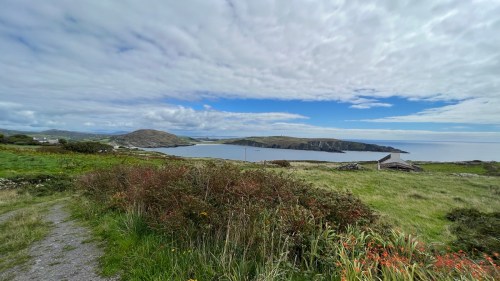With bad weather moving in Marce found us a quaint little harbor for a safe parkup to wait out the rain.

What it lacked as a proper harbor it made up for with a magnificent 1885 twelve arch railroad viaduct allowing rail service to Schull.

Now it’s part of a foot trail. Ballydehob is located at the confluence of the Bawnaknockane River and Roaringwater Bay, bounded by the Atlantic Ocean. Dodging rain drops I managed to grab some excellent takeout food without getting too wet and marveled at the remarkable number of sophisticated restaurants this cute little town has.

Ballydehob has managed gentrification via the usual route of artist colony, fine cuisine, and yachts.


The town certainly seems in an ebullient mood with festivals for every taste.

We heard that this weekend they’re having a BBQ, music, and traditional wooden boat festival so we’re definitely sticking around for that. Not the best weather for a BBQ but the good citizens of Ballydehob haven’t seemed to notice.

The wharf is really filling up with those well dressed citizenry. The band is kind of fun and the sausage baps are great.

We’ve even heard that sometimes Jeremy Irons sails up from Rocky Mannin Beg Island where his Kilcoe Castle overlooks Roaring Water Bay.


It’s time for the main event when one at a time the old traditional boats round the little island and arrive to deal with the Southern breeze setting the boats in towards the docks, rocks and concrete pier.

Some were more successful than others.

They need the pull of the sail to come into the little harbor but once in they need it doused in a hurry. Nothing happens in a hurry with these old boats.

I noticed one last traditional tanbark sail has come around the small protective island.

It dithered about, just off the harbor, shortening sail, then she headed in.

Everybody turned and watched. Every sailor’s nightmare.

I noticed Skipper change his mind and head over towards the concrete pier but with a little too much steam on, and having made this mistake a few times myself, I helped fend off just in time.

As soon as things calmed down I looked up and saw the skippers eyes. They were the deep brown eyes of Jeremy Irons.

To be honest his crew appreciated the help and it took some wrangling to get the dock lines sorted, but his locally made wooden boat, “Willing Lass” is simple and beautiful.

You never know what might happen wandering around Ireland.













































































































































































































